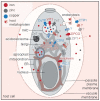Orchestrating a heist: uptake and storage of metals by apicomplexan parasites
- PMID: 34898419
- PMCID: PMC7612242
- DOI: 10.1099/mic.0.001114
Orchestrating a heist: uptake and storage of metals by apicomplexan parasites
Abstract
The acquisition and storage of metals has been a preoccupation of life for millennia. Transition metals, in particular iron, copper and zinc, have vital roles within cells. However, metals also make dangerous cargos; inappropriate uptake or storage of transition metals leads to cell death. This paradox has led to cells developing elegant and frequently redundant mechanisms for fine-tuning local metal concentrations. In the context of infection, pathogens must overcome further hurdles, as hosts act to weaponize metal availability to prevent pathogen colonization and spread. Here, we detail the methods used by the Apicomplexa, a large family of eukaryotic parasites, to obtain and store essential metals.
Conflict of interest statement
The authors declare that there are no conflicts of interest
Figures

Similar articles
-
Transport and storage of metals.J Inherit Metab Dis. 1983;6 Suppl 1:9-14. doi: 10.1007/BF01811317. J Inherit Metab Dis. 1983. PMID: 6413780
-
Inhibition of iron and copper uptake by iron, copper and zinc.Biol Res. 2006;39(1):95-102. doi: 10.4067/s0716-97602006000100011. Biol Res. 2006. PMID: 16629169
-
Facing the challenges of Cu, Fe and Zn homeostasis in plants.Nat Chem Biol. 2009 May;5(5):333-40. doi: 10.1038/nchembio.166. Nat Chem Biol. 2009. PMID: 19377460 Free PMC article. Review.
-
Differential Effects of Iron, Zinc, and Copper on Dictyostelium discoideum Cell Growth and Resistance to Legionella pneumophila.Front Cell Infect Microbiol. 2018 Jan 11;7:536. doi: 10.3389/fcimb.2017.00536. eCollection 2017. Front Cell Infect Microbiol. 2018. PMID: 29379774 Free PMC article.
-
The molecular biology of metal ion transport in Saccharomyces cerevisiae.Annu Rev Nutr. 1998;18:441-69. doi: 10.1146/annurev.nutr.18.1.441. Annu Rev Nutr. 1998. PMID: 9706232 Review.
Cited by
-
Microbial Musings - December 2021.Microbiology (Reading). 2021 Dec;167(12):001141. doi: 10.1099/mic.0.001141. Microbiology (Reading). 2021. PMID: 35099370 Free PMC article. No abstract available.
-
Towards next-generation treatment options to combat Plasmodium falciparum malaria.Nat Rev Microbiol. 2025 Mar;23(3):178-191. doi: 10.1038/s41579-024-01099-x. Epub 2024 Oct 4. Nat Rev Microbiol. 2025. PMID: 39367132 Review.
-
An essential role for an Fe-S cluster protein in the cytochrome c oxidase complex of Toxoplasma parasites.PLoS Pathog. 2023 Jun 1;19(6):e1011430. doi: 10.1371/journal.ppat.1011430. eCollection 2023 Jun. PLoS Pathog. 2023. PMID: 37262100 Free PMC article.
-
Iron transport pathways in the human malaria parasite Plasmodium falciparum revealed by RNA-sequencing.Front Cell Infect Microbiol. 2024 Nov 7;14:1480076. doi: 10.3389/fcimb.2024.1480076. eCollection 2024. Front Cell Infect Microbiol. 2024. PMID: 39575308 Free PMC article.
-
Iron depletion has different consequences on the growth and survival of Toxoplasma gondii strains.Virulence. 2024 Dec;15(1):2329566. doi: 10.1080/21505594.2024.2329566. Epub 2024 Mar 20. Virulence. 2024. PMID: 38509723 Free PMC article.
References
-
- Almeida MPO, Ferro EAV, Briceño MPP, Oliveira MC, Barbosa BF, Silva NM. Susceptibility of human villous (BeWo) and extravillous (HTR-8/SVneo) trophoblast cells to Toxoplasma gondii infection is modulated by intracellular iron availability. Parasitol Res. 2019;118:1559–1572. doi: 10.1007/s00436-019-06257-2. - DOI - PubMed
-
- Al-Sandaqchi AT, Brignell C, Collingwood JF, Geraki K, Mirkes EM, Kong K, Castellanos M, May ST, Stevenson CW, Elsheikha HM. Metallome of cerebrovascular endothelial cells infected with Toxoplasma gondii using μ-XRF imaging and inductively coupled plasma mass spectrometry. Metallomics. 2018;10:1401–1414. doi: 10.1039/c8mt00136g. - DOI - PubMed
Publication types
MeSH terms
Substances
Grants and funding
LinkOut - more resources
Full Text Sources

